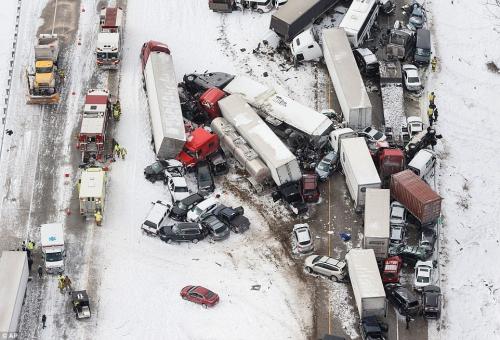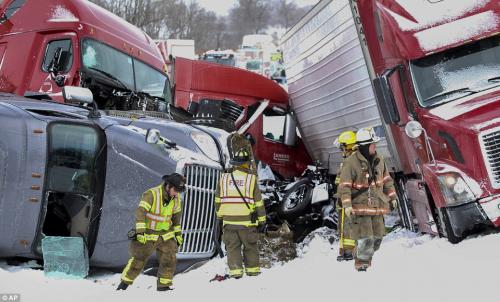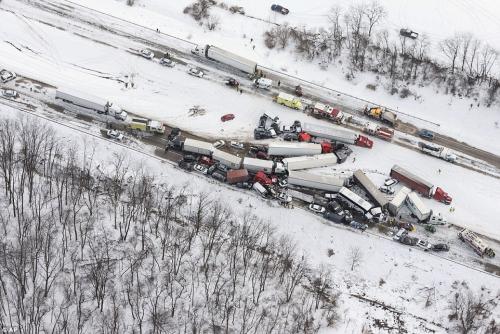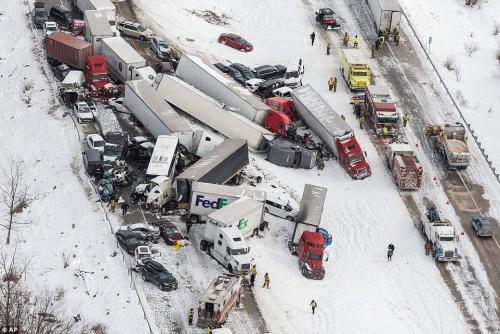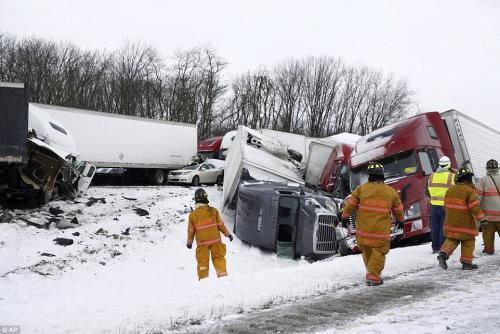
kscarbel2
Moderator-
Posts
17,891 -
Joined
-
Days Won
86
Content Type
Profiles
Forums
Gallery
Events
Blogs
BMT Wiki
Collections
Store
Everything posted by kscarbel2
-
Nikkei Asian Review / February 17, 2016 Volvo Group subsidiary UD Trucks will stop manufacturing midsize models in Japan, procuring such vehicles from Isuzu Motors as the company channels those resources into development and production of larger trucks. UD plans to sell rebadged Isuzu trucks beginning next year under an original equipment manufacturing agreement, Volvo Group said Tuesday. Those vehicles, which will be based on the Isuzu “Forward” medium truck, will be supplied from Isuzu's Fujisawa plant in Kanagawa Prefecture. UD's Ageo plant in Saitama Prefecture will cease production of medium trucks for Japan in 2017. The Japanese truckmaker aims later to stop making medium trucks for overseas markets as well. The plant will continue manufacturing large trucks. This is the company's second OEM agreement with Isuzu. The first one, covering light trucks, began in 1995 but was terminated in 2014 as UD switched the procurement source to Daimler subsidiary Mitsubishi Fuso Truck and Bus. With the transport ministry tightening emissions controls for trucks and buses, new trucks released after this summer will have to meet new standards. UD, which holds only around a 6% share in the domestic midsize truck market, decided to source the vehicles from another manufacturer rather than developing a new model by itself. Though UD will be selling only OEM models in the Japanese light and medium truck segments, the company will focus on raising its domestic share in large trucks to 25% from the current 17% as soon as possible. In 2015, UD sold over 2,000 medium trucks in Japan. But that number was less than one-quarter of the company's sales for large trucks. Outside Japan, UD aims to bolster efforts to cultivate emerging markets by manufacturing models targeting them in Thailand and elsewhere. Japan's combined sales of medium and large trucks rose 1.4% to 89,321 units in 2015, increasing for the sixth consecutive year. Demand has been robust from the construction and distribution industries, which have benefited from building projects related to the 2020 Summer Olympics in Tokyo and the growing popularity of online shopping, respectively. UD, which traces its roots to Nissan Diesel Motor Company, has struggled to rise from its bottom market position, as truckmakers Hino, Isuzu and Fuso have more extensive service networks.
-
Experts Wanted!
kscarbel2 replied to thomastractorsvc's topic in Antique and Classic Mack Trucks General Discussion
The R had a 9" x 3-1/4" x 1/4" frame (with optional 1/4" inside frame reinforcement). For tanker operations that wanted a stronger frame without the added weight of inside frame reinforcement, the base level RD frame was made available (for tractors only), that being 10-5/8" x 3-1/4" x 5/16". The RD6 came standard with a 10-5/8" x 3-1/4" x 5/16" frame (with optional 1/4" inside frame reinforcement). The RD6 could be optioned with a 10-3/4" x 3-1/4" x 3/8" frame (with optional 1/4" inside frame reinforcement). -
http://www.miamiherald.com/news/local/community/miami-dade/article60522706.html
-
The Wall Street Journal / February 15, 2016 Daimler AG said it would lay off more than 1,200 workers this week at a pair of North Carolina assembly plants in response to falling demand for commercial trucks. Daimler's North America truck unit, which makes Freightliner trucks, said Monday it plans to furlough 550 workers at its Cleveland, N.C., assembly plant, a quarter of the plant's employees. More than one-third of the workforce at Daimler's Mount Holly plant, about 700 employees in all, will be laid off as well. The layoffs will take effect Friday. The Mount Holly plant, which builds medium-duty trucks, will drop to two work shifts a day from three for the 1,450 workers remaining on the job. The 1,600 workers left at the Cleveland plant will work a single daily shift. The plant had previously operated with two shifts. The Cleveland plant, which assembles heavy trucks, already trimmed more than 900 workers in early January. Daimler workers losing their jobs this week will be paid through April to comply with federal notifications rules for large-size layoffs. Freightliner is the market leader in sales of heavy-duty trucks in North America. Rival truck makers Volvo and Paccar Inc. also have recently trimmed their production and employees. After a stretch of elevated buying of trucks in recent years, trucking companies have been scaling back their purchases as U.S. industrial activity slows and demand for freight-hauling service weakens. January orders for heavy-duty trucks in North America fell by nearly 50% from a year earlier to about 18,200 vehicles. Production of heavy trucks in 2016 is expected to be down 10% to 20% from 2015. Related reading - http://www.bigmacktrucks.com/index.php?/topic/43388-freightliner-to-cut-almost-1000-jobs-at-cleveland-nc-truck-plant/?hl=daimler
-
Autoblog / February 15, 2016 Back in 1881, a pair of Cincinnati brothers decided to get into the fresh produce racket. Along the way to becoming an iconic presence in the area, they invested in a 1928 Model 10 Walker Electric Truck. Sadly, and to the surprise of many, Gentile Bros. Co. folded in 2013, but that truck lives on. After a life of schlepping carrots and cabbage, it mysteriously made its way down to Palm Springs, California, where it's spent a quiet retirement working on a fine patina. Rescued from a five-year stint out in the weather by Greg Gunkel, the pickup amazingly, once again, came to life with the addition of a set of tires and a trio of 12-volt batteries. Quite possibly the last of its kind – we've searched high and low for other examples of Walker Electric Trucks and have found only a handful, and none like this configuration – Gunkel has offered it up on Craigslist in hopes it can find a good home in the hands of a museum or collector. It comes with a set of California "historical vehicle" license plates and a reprint of a booklet entitled "Instructions for the care and use of Model 10 light delivery Walker Electric Trucks." Asking price is a soft $40,000.
-
International Truck Launches “HX” Vocational Series
kscarbel2 replied to kscarbel2's topic in Trucking News
International receives orders for more than 300 HX Series trucks Truck News / February 15, 2016 International Truck says its new HX Series vocational truck, introduced earlier this month at World of Concrete, has been well received. It just received it largest order yet for the truck, with 15 HX620 dump trucks going to RLJ Thompson Trucking in Concord, Va. The trucks are powered by the Cummins ISX15 engine. “We already have orders for more than 300 trucks and that number is growing by the day,” said Jeff Sass, senior vice0president, sales and marketing, Navistar. “This interest is fuelled by how we designed our new HX Series based on in-depth discussions with leading Class 8 vocational customers. Each of the four models in the series has been engineered to deliver unmatched performance for the most punishing jobsites while also making operators more productive.” “We ordered the new HX Series trucks because we are excited about the bold design that offers a sturdy, yet lightweight truck powered by the ISX engine,” added Ricky Thompson, president of RLJ Thompson Trucking. -
EPA target is defeat devices, not racers Automotive News / February 15, 2016 Aftermarket parts makers are warned Alarm bells rang in the auto enthusiast community last week after a trade group warned that the EPA was threatening to ban the type of modified street cars that generations of amateur racers have taken to the track. Relax, the EPA said. There's no new ban being proposed. Fact is such modifications have always been banned under the Clean Air Act. So what is going on? Call it a muddled exchange that nonetheless sheds light on one of the EPA's enforcement priorities in the context of Volkswagen's diesel transgressions. In short, the EPA's concern is not about the emissions of race cars but about keeping all road-going cars free of modifications that would neuter their emissions controls. Adam Kushner, a partner at the law firm Hogan Lovells and former enforcement official at the EPA, says it should be no surprise these days that regulators are scrutinizing how emissions-control systems are being modified in the new-vehicle and aftermarket sectors. "The regulated community is going to need to be watchful," said Kushner, who was director of the EPA's Air Enforcement Division from late 2003 to late 2008 and director of its Office of Civil Enforcement from late 2008 to late 2011. The EPA proposal that sparked last week's controversy seeks to add language to a "prohibited acts" section of existing light-vehicle regulations saying certified motor vehicles and their emissions components "must remain in their certified configuration even if they are used solely for competition or if they become nonroad vehicles or engines." The EPA's addition was tucked inconspicuously into the agency's 629-page proposal to set 2021-27 medium- and heavy-vehicle greenhouse gas targets. It was published in the Federal Register in July 2015. The EPA is expected to issue its final rule for the big truck standards in July and is still considering comments from the public. The disputed language was meant to clarify that a separate exemption for "nonroad" vehicles, such as all-terrain vehicles, snowmobiles and dirt bikes, didn't extend to motor vehicles, according to Laura Allen, the EPA's deputy press secretary. Yet it was seized on by the Specialty Equipment Market Association, which last week warned that the rule would expose racers and some aftermarket companies that serve them to penalties and reverse decades of agency policy on the issue. "This is a change of heart in terms of their interpretation of the law," said Steve McDonald, SEMA's vice president of government affairs. That's not the case, according to the EPA. While the agency has long had a rule on its books against tampering with the emissions controls on light-duty vehicle engines -- that is, prohibiting the very thing that many racers do to extract more power from their track cars -- the rule has never been an enforcement priority. The agency's de facto posture is: Let racers race. Indeed, despite the many thousands of racers who are technically in violation of the Clean Air Act and have been for years, Allen told Automotive News, the EPA has never taken an emissions-tampering enforcement action against a vehicle owner who "has proven the tampered vehicle was used exclusively for racing." The agency has, however, gone after some aftermarket companies that sold parts to defeat emissions-control equipment, entering into consent decrees with at least three companies since 2007. In one case, the EPA and the Department of Justice secured a settlement in 2007 with Casper's Electronics Inc., which sold aftermarket oxygen "simulators." The electronic add-on part could send a false signal to a car's computer that its emissions systems were working properly even if they had been removed or disabled, according to the EPA. Casper's marked the sensors for "off-road" or "nonroad" use only but designed and marketed them to be used in production cars driven on public streets, according to the EPA. "The EPA remains primarily concerned with cases where the tampered vehicle is used on public roads, and more specifically with aftermarket manufacturers who sell devices that defeat emission-control systems on vehicles used on public roads," Allen said. Kushner said that has long been a concern within the halls of the EPA's air quality division. Now it's getting a closer look because of Volkswagen. "EPA's enforcement occurs in waves," Kushner said. "The times dictate what wave you're going to ride. Right now, we're on the defeat-device tampering wave." Agony of defeat devices Since 2007, the EPA has brought 3 enforcement cases against automotive aftermarket companies for selling "defeat devices" — defined as parts or services that illegally tamper with emissions systems on road-going vehicles. The fines reflected reductions based on the companies' ability to pay. • Casper's Electronics Inc., 2007: A consent agreement with the EPA and Department of Justice ordered the company to pay $80,000 for selling some 44,000 plug-in oxygen "simulators" that could send a false signal to the vehicle's computer that its emissions controls were functioning properly even if they had been disabled or removed. Casper's also was required to recall the product, pay refunds to buyers and destroy its remaining inventory. • Edge Products, 2013: Company was fined $500,000 for selling electronic products that allowed owners of diesel pickups to operate them without the diesel particulate filter and emit clouds of black exhaust smoke. Edge also had to spend at least $157,600 on projects to mitigate the excess emissions caused by the units. • H&S Performance, 2015: The truck-tuning company was hit with a $1 million fine for selling thousands of devices for diesel pickups that allowed owners to disable diesel particulate filters and exhaust-gas recirculation systems.
-
In part 2 of 2, at the very beginning, Ernest Borgnine's navy time in China is mentioned. At about 4:38 minutes, they talk about the boat. There was a real boat, as seen in the show's intro. For the H-4 Hercules seaplane project (aka Spruce Goose), Howard Hughes requested from the Navy two PTs for use as chase boats that, produced at the end of the war, were new and available. Several PT boat designs were produced, such as the PT305 from Higgins, and the Elcos. But the PT-73 was a U.S.-produced British design 70-foot Type 2 Vosper, produced under license during the war. The boats on the set (lake), as they say, were downsized, non-powered and made of cardboard.
-
-
During his first six year tour, Ernest Borgnine served in China, which means he was on the Yangtze Patrol (https://en.wikipedia.org/wiki/Yangtze_Patrol), a unit of the U.S. Navy's Asiatic Fleet (https://en.wikipedia.org/wiki/Asiatic_Squadron).
-
-
The Maritime Executive / February 11, 2016 One of the handful of remaining wooden PT boats, made famous by their service in the Pacific in WWII, is being restored in an all-volunteer effort by the National WWII Museum. PT-305, built by Higgins Industries in New Orleans, was deployed in World War II in the Mediterranean Theater; she entered commercial service as a tour boat and a workboat after the war. “Virtually everything has to be remanufactured,” said Bruce Harris, restoration coordinator on the project. “We're using the same materials as used originally,” He said that as many as 30 to 40 volunteers show up to work on the project on the weekends, and they hail from all walks of life – from naval architects to students to small business owners. “We're finding that the as-built vessel deviated quite a bit from the design,” said a volunteer. And finding spares for her three supercharged Packard aircraft engines is not as simple as it might be for a small-block V-8. “We could take one apart, put it back together in 6 to 8 weeks if we had new parts. But every part you take off of it, you have to recondition it . . . and if you can't find it, you have to make it.” There are only a few remaining PT boats in the United States, and only one is presently functional. PT-658, based in Portland, Oregon, was restored to original plans by a group of PT boat veterans in the 1990s. She is on the National Register of Historic Places. Including all vessel types and experimental models, nearly 800 boats bearing the PT designation were built between 1939 and 1945. They saw service all over the world, but are perhaps best known for action in the Pacific Theater, where they disrupted Japanese supply shipments in shallow waters where larger naval vessels could not go, conducted reconnaisance and carried out night attacks. The boats were valued for their maneuverability, speed, and low cost of construction; their wooden hulls and small size freed up space at larger naval shipyards, too, as smaller boatbuilders took on the task of sending them down the ways. Famous PT boats included PT-41, which led a squadron of boats to carry General Douglas MacArthur, his family and his staff from Corregidor Island as Japanese forces advanced. They evaded a Japanese cruiser and safely transported the officers to Mindanao. Lieutenant John Bulkeley received the Medal of Honor for his leadership in the evacuation PT-109, under the command of future president Lieutenant John F. Kennedy, was rammed and sunk by a Japanese warship in the Solomon Islands. Her eleven surviving crew took shelter on a nearby island and were rescued with assistance from local coastwatch members. This book is a must-read (the movie doesn't come close). Buy it new, or used good condition - http://www.amazon.com/They-Were-Expendable-Philippines-Bluejacket/dp/1557509484
- 29 replies
-
- 12
-

-
Fleet Owner / February 12, 2016 New book argues trucking takes advantage of new and naïve drivers The trucking industry often takes advantage of new drivers and thrusts them into an unsustainable employment cycle resulting in dissatisfied workers, massive turnover and chronic labor shortages, according to a forthcoming book. Truck driving, once a way to climb the nation's economic ladder, now has fallen short of that promise, says Stephen Viscelli, author of The Big Rig: Trucking and the Decline of the American Dream. "The transformation of labor markets in trucking has disempowered workers to the point where it’s rigged in the favor of employers. Driving doesn't provide the kind of opportunities that people were expecting," he says. "People within the industry know all the pieces of the puzzle that I write about in the book. Nobody in the industry is going to be surprised that drivers are misled or that they misunderstand what’s happening to them or that companies offload economic risk to them." Viscelli is an economic sociologist who focuses on labor markets and has studied the trucking industry more than ten years. He is a visiting assistant professor at Swarthmore College and Senior Associate of the Center on Wisconsin Strategy. He not only interviewed drivers, managers, shippers and others involved in the industry, but he worked and trained as an Over-The-Road driver for six months. He says that the industry is unfair to drivers at every stage of their careers. "You can see evidence of it in every step of the labor process from the advertising of incomes that aren’t actually happening to the segments [like contracting] that people are being attracted to but don't turn out as expected." It starts with training. "The industry now has systematically offloaded a large chunk of their training costs to the public and workers," says Viscelli. "Essentially you have anywhere from 150,000 to 200,000 workers when times are good circling into the industry and being burdened with debt for training… The cost of training contracts that many companies use also serves as a form of incentive for people to stay. Some would call it debt where you’re burdened with a $3,000 to $5,000 charge at 24 percent interest or whatever if you don’t work for the company for a year. Most of the workers I interviewed coming into the industry don’t understand that. They only see it on the back side. The more experienced drivers know this is happening [to the new drivers]. They talk about the 'CDL mill' and the 'professional steering wheel holder,' and it’s all very well known to folks who are in the industry. It’s just the people coming in who aren’t as aware." At the next stage of a driver's career comes the realization that they're working without being paid. "There are tons of unpaid time sitting at docks and in traffic and the shifting of all these inefficiencies to new drivers. The inexperienced drivers that most big truckload companies are relying on don’t know any other way to do trucking so they don’t have a problem with pay-per-mile or sitting unpaid at docks - at first." As a driver becomes more experienced, he or he realizes that this form of unpaid labor is unfair and they want to change their situation. "When drivers finally realize it - and it doesn’t take them very long - they want to get paid for that time, and they want control over their load assignments. That's when they look at independent contracting." Viscelli spent most of his time looking at independent contracting, which, for many drivers would be "the American dream" of being your own boss, making as much money as your skills, time, experience and ambition allow. Here again, he paints a less than rosy picture. "The industry has been able to completely redefine what it is to get people to work under what effectively becomes a forced-dispatch system and practice, according to the drivers I talk to. They work for the same pay rate regardless of the quality of the load. They don’t have control over the loads or the home time that they expected. The vast majority end up making less than they would as a company driver… Then, one, two, three years in, they see better opportunities open up for them in much better-paying private fleet niche markets. It has become a retention strategy by TL carriers to get people whose labor is worth more to stick around an extra six months, year, or whatever they can." Viscelli says that he interviewed many drivers who were considering contracting, those who were in the midst of setting up their independent contracting business, and those who were currently contracting. "Basically, none of them got out of it what they expected. Even the most successful contractors said they would never do it again. The opportunity is just not there. The kind of picture that’s painted for you about what’s possible is just not accurate. For a lot of these guys, that’s how they describe it, and it wasn’t why they got into the industry. Ninety-eight percent of them don’t come in thinking 'I’m going to own my own trucking business.' Most of them are low-wage workers downsizing from a blue collar job or upscaling from a retail job; they’re not thinking about business ownership. Most of them are thinking about improving what is most likely an under $30,000 a year household income. The industry sells them on this dream [of independent ownership]; it does it through websites and promotions that create a kind of new American dream." He notes that not all carriers engage in unfair behavior. "Of course, some companies treat their drivers with respect, pay them well, and their drivers enjoy their jobs." Can this cycle be broken? "I don’t know that I have a solution for it but the book looks at the way in which these kinds of transformations have happened. Go back to the teamsters. They solved a lot of these problems because they took wages out of competition; they ensured that there was low turnover. However, that's not a solution that the industry is going to be very interested in." Viscelli says that the industry can change if it makes some bold moves. For example, they can get drivers home by forming regular lanes where drivers drop trailers and head back the other way, the way some LTL carriers do it. This would require a large investment in infrastructure either privately or publicly to build truck ports. Would pay-by-the hour help alleviate solve many of the industry's driver issues? "You’d have to have a bold company willing to do that first, because market forces make it difficult to change [the current model]," says Viscelli. "I have interviewed many company owners. I understand it’s a conservative industry and I don’t expect individuals to be able to overcome the market economic forces that have brought this about [pay-by-the-mile]. From deregulation on, it's been tough to be a trucking company and get the bottom line that you need to survive. I think the big companies have managed to do that now… It's potentially a time when some of the more profitable big truckload companies can start to change their model. I think some of them are interested in doing it." But they probably won't, he says. "If we could get the top 100 companies with the lowest freight rates to pay their drivers by the hour, that would have an unbelievable impact. But I don’t think there's one company willing to take that risk. Drivers need to be paid more; they need a bigger cut of the revenue, but unless that translates into higher freight rates, it’s going to mean lower profits. Companies know that and that's why they’re not going to pay drivers by the hour." The Big Rig: Trucking And The Decline of The American Dream will be published in April by University of California Press.
-
You can’t choose your neighbors, and the odds of them all becoming your best friends with whom you agree with on every issue are slim to none. Our world has become a much smaller place, and certainly one filled with more dangers which test our ability to intercept and neutralize them. It mystifies me why we can’t work with Russia on the destruction of ISIS, allowing us to form a working relationship with a country that is far better as a global partner than as an enemy. Breaking News: ISIS and radicalized Islam are a global threat. The U.S. and Russia as partners can not only neutralize this threat, but also guide the world in a better direction. As Jack Moniker (Robin Williams) said so well in the movie “Club Paradise”: “It's amazing how people can get themselves in these situations when, if you stop and think about it, you'll see that basically, you guys are not that far apart on this thing.” The day likely will come when mankind realizes that it has wasted years fighting amongst itself, rather than coming together to meet the future challenges it as a whole will face. Food for thought, renowned Cambridge professor Stephen Hawking recently said: “Although the chance of a disaster to planet Earth in a given year may be quite low, it adds up over time, and becomes a near certainty in the next 1,000 or 10,000 years.” Rather then continuing the centuries-old saga of trying to annihilate ourselves, Hawking hopes that mankind could escape the earth’s demise is by venturing into space. “By that time, we should have spread out into space, and to other stars, so a disaster on Earth would not mean the end of the human race.” says Hawking. Such an effort of course, would require a mature mankind that has gotten its priorities in order. If not, Hawking imagines that the earth’s demise will be precipitated by catastrophes of our own making, including nuclear war, genetically engineered viruses and global warming. Imagine another scenario………If there are advanced aliens in space, there’s a 50-50 chance they’re not “nice guys.” "Such advanced aliens would perhaps become nomads, looking to conquer and colonize whatever planets they could reach," says Hawking. "If so, it makes sense for them to exploit each new planet for material to build more spaceships so they could move on. Who knows what the limits would be?" "We don't know much about aliens, but we know about humans. If you look at history, contact between humans and less intelligent organisms have often been disastrous from their point of view, and encounters between civilizations with advanced versus primitive technologies have gone badly for the less advanced. A civilization reading one of our messages could be billions of years ahead of us. If so, they will be vastly more powerful, and may not see us as any more valuable than we see bacteria." [worse, they might not appreciate the sight of a pre-2000 Mack truck] If mankind managed to become less violent and shortsighted, and realize we’re all on the same boat (planet), imagine what we could do if we focused our defense spending and development on a united planetary defense system, and advanced spacecraft development (recall how far technology leaped, from 1939 to 1945....it's possible). ----------------------------------------------------------------------------------------- The Guardian / February 13, 2016 Russian Prime Minister Dmitry Medvedev at a security conference in Munich said the world is slipping into a “new cold war” after European leaders condemned his country’s airstrikes on Syria and called on Vladimir Putin to end them as a precursor for peace negotiations. Medvedev said a lack of cooperation threatened to return the continent to “40 years ago, when a wall was standing in Europe”. He rejected the widely held belief that Russian planes had hit civilian targets in Syria. “There is no evidence of our bombing civilians, even though everyone is accusing us of this,” he said on Saturday. “Russia is not trying to achieve some secret goals in Syria. We are simply trying to protect our national interests … “Creating trust is hard … but we have to start. Our positions differ, but they do not differ as much as 40 years ago when a wall was standing in Europe. “You could say even more sharply: we have fallen into a new cold war,” he said. “Nearly on a daily basis, we are being blamed for the most terrible threat to NATO as a whole, to Europe, to America, to other countries. They make scary movies where Russia starts a nuclear war. I sometimes wonder: are we in 2016 or 1962?” Russian Foreign Minister Sergey Lavrov said military cooperation between the US and Russia was the “key tool” to ensuring the humanitarian supplies were delivered and hostilities ended. “If we are moving closer to practical goals of [a] truce then, without cooperation between the military, nothing will work out,” he told the Munich conference.
-
-
-
RD steel nose
kscarbel2 replied to Timothy Maikshilo's topic in Antique and Classic Mack Trucks General Discussion
The Ward 79 steel hood retrofit was available for the RD (http://www.bigmacktrucks.com/index.php?/topic/34104-the-ward-79-steel-hood-retrofit/?hl=ward#entry225305). -
In the same vein, United Technologies subsidiary UTC Climate, Controls & Security announced on Wednesday to thrilled employees that it will relocate its Carrier brand heating and air conditioning plants in Indianapolis and Huntington, Indiana to Mexico. Altogether, 2,100 American workers will lose their jobs. Can you hear that "giant sucking sound", of big business-lobbied NAFTA draining millions of American jobs to lawless Mexico?
-
U model cab
kscarbel2 replied to mackr400's topic in Antique and Classic Mack Trucks General Discussion
Sounds like your cab is a Mack type CA363. CA36 (pre 1973 R-model) CA361 (pre 1973 U-DM) CA363 (post 73-81 U-model) CA49 (post 73 R/RD/RS/RL - fiberglass and steel hood) CA491 (post 73 DM - fiberglass hood / 81' on U-model) CA492 (post 73 DM - steel hood) CA494 (RWI600/700 Super-Liner) -
"People should and do trust me" - Hillary Clinton
kscarbel2 replied to kscarbel2's topic in Odds and Ends
https://www.yahoo.com/politics/hillary-clinton-and-bernie-sanders-spar-over-super-043334749.html -
"People should and do trust me" - Hillary Clinton
kscarbel2 replied to kscarbel2's topic in Odds and Ends
Democratic candidates Hillary Clinton and Bernie Sanders clashed over support for the president at a PBS NewsHour televised debate. Clinton sought to cast herself as the protector of Barack Obama's legacy, sharply attacking Mr Sanders for criticising the president. "The kind of criticism I hear from Senator Sanders, I expect from Republicans," Clinton said. "Madame secretary, that is a low blow,' Sanders replied. 'I have worked with President Obama for the last 7 years. One of us ran against Barack Obama, I was not that candidate." At the debate, Clinton repeatedly emphasised her ties to Obama, who is extremely popular among minority voters. Sanders took pains to tailor to his message of economic fairness to address disparities in black communities. Clinton also stressed her pragmatism, questioning Sanders' pledges to provide universal healthcare and free higher education. "We have a special obligation to make clear what we stand for which is why we can't make promises we can't keep," Clinton said. -
The "Factory Branches" of Mack Trucks, Inc.
kscarbel2 replied to kscarbel2's topic in Modern Mack Truck General Discussion
Joe, Scranton is one that goes back a long ways. It came into existence in the late 1920s. -
"People should and do trust me" - Hillary Clinton
kscarbel2 replied to kscarbel2's topic in Odds and Ends
Former secretary of state Madeleine Albright introduced Hillary Clinton at an event in New Hampshire on Saturday, telling the crowd and voters in general: “There’s a special place in hell for women who don’t help each other!" Albright said: “When she was secretary of state, she restored America’s reputation. Those other people before made huge mistakes. They really undermined our reputation and our position in the world, and Hillary Clinton brought us back, she restored our position in the world." (the total opposite of the truth.......not sure what color the sky is in Albright's world). Following that, Clinton's supporters chanted “Madam President! Madam President!” Normal ranting during the Presidential Elections shows. http://www.theguardian.com/us-news/2016/feb/06/madeleine-albright-campaigns-for-hillary-clinton If a reporter flattered Clinton with the title, perhaps they were hoping for an exclusive with Clinton. They would be worth a bonus, raise and/or promotion. -
Reuters / February 11, 2016 Armed protesters who ended their 41-day standoff on Thursday at a wildlife refuge in Oregon told federal authorities they left behind booby traps but did not say whether the trip wires and other devices would trigger explosions, a law enforcement official told Reuters. "They spoke to us about booby traps. We don't know how sophisticated or what kind," said the official. Materials to create explosives could be found on the refuge, the official said, because workers there previously performed controlled burns of the land. The official said law enforcement would use caution when moving into the refuge in remote eastern Oregon. "There were materials that could be used to create hazardous devices, so it's just very prudent for us to do to that," the official said. The final four occupiers left the Malheur National Wildlife Refuge on Thursday and joined 12 other occupiers to face federal charges. The takeover, which began on Jan. 2, was sparked by the return to prison of two Oregon ranchers convicted of setting fires that spread to federal property in the vicinity of the refuge. The armed protesters, originally led by brothers Ammon and Ryan Bundy, were known to be heavily armed and resistant to the federal government. Ammon and Ryan Bundy were arrested on Jan. 26 and have since called for protesters to leave. Their father, Cliven Bundy, flew to Oregon on Wednesday to support the movement but was arrested at the Portland airport on charges stemming from the 2014 standoff on his Nevada ranch. The official said law enforcement arrested Cliven Bundy at the airport because they knew he would be unarmed and the charges against him were ready.
BigMackTrucks.com
BigMackTrucks.com is a support forum for antique, classic and modern Mack Trucks! The forum is owned and maintained by Watt's Truck Center, Inc. an independent, full service Mack dealer. The forums are not affiliated with Mack Trucks, Inc.
Our Vendors and Advertisers
Thank you for your support!


